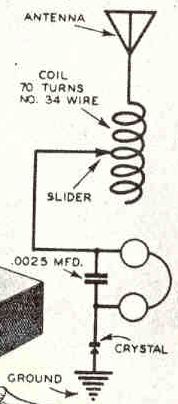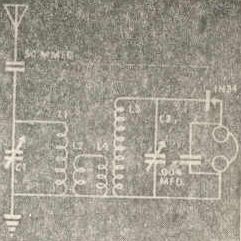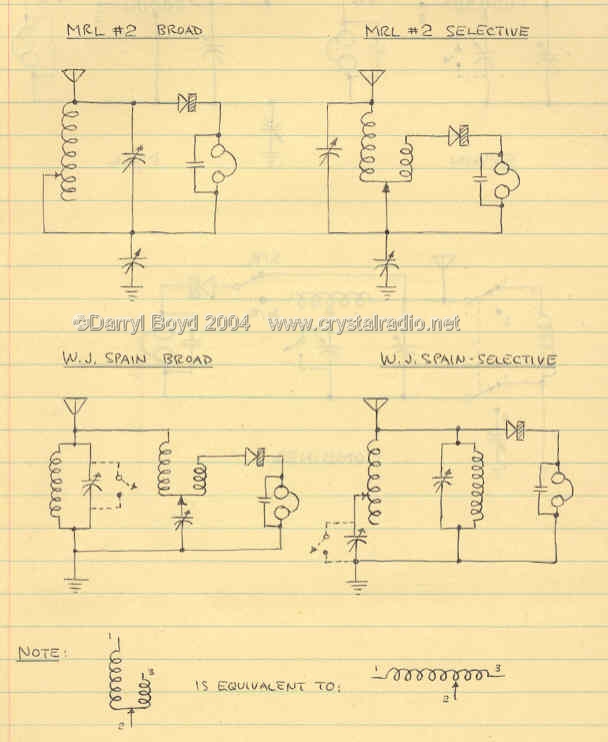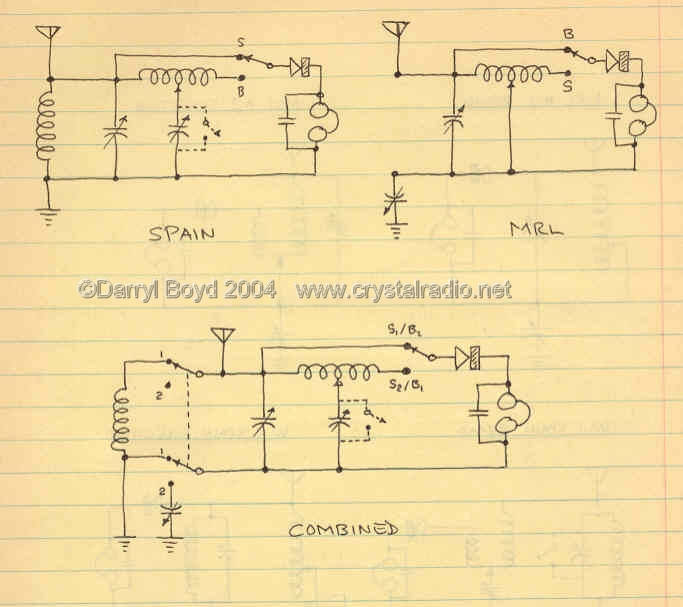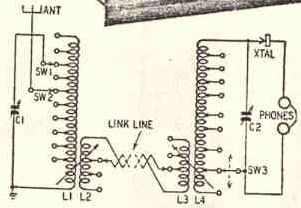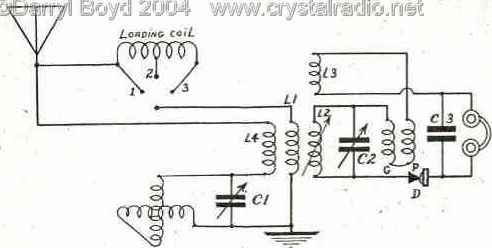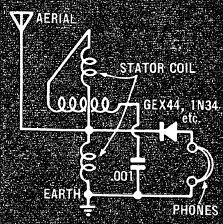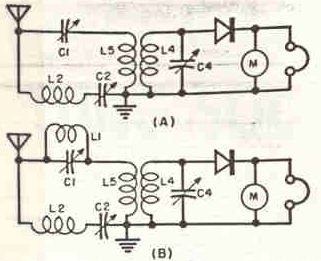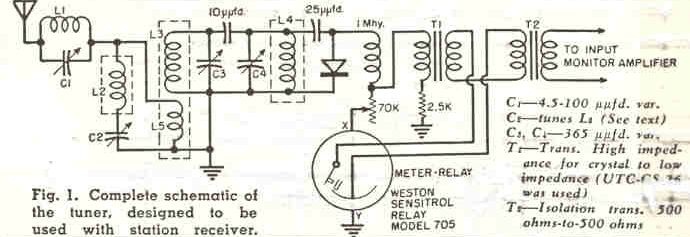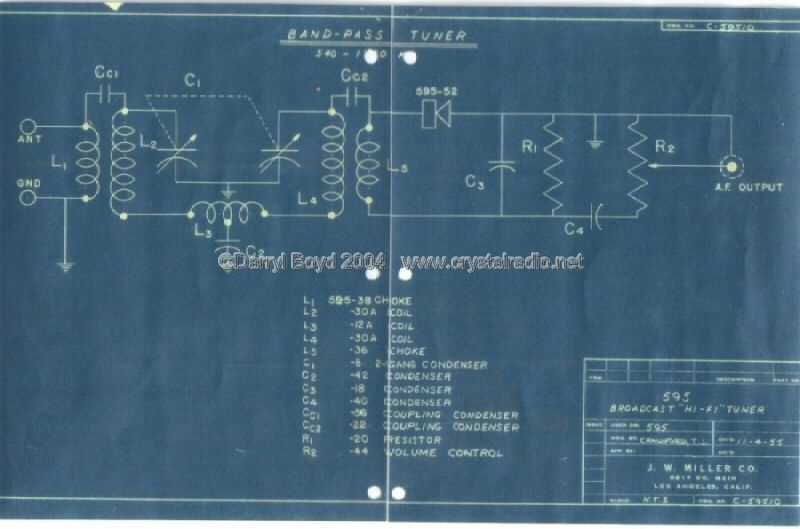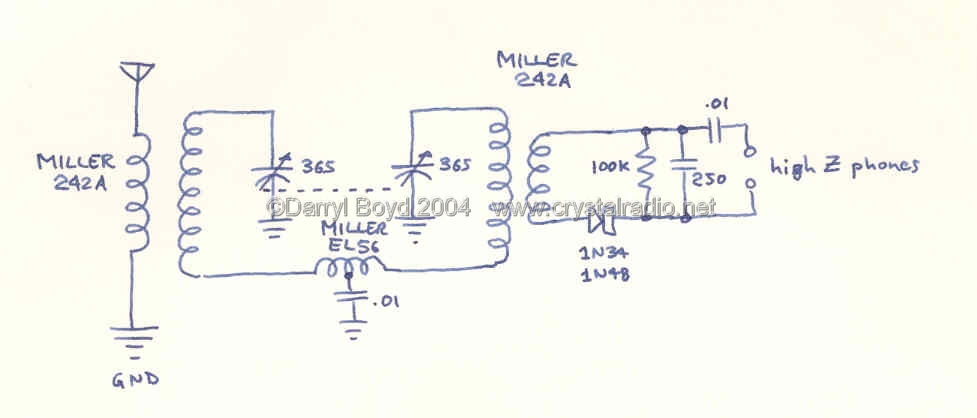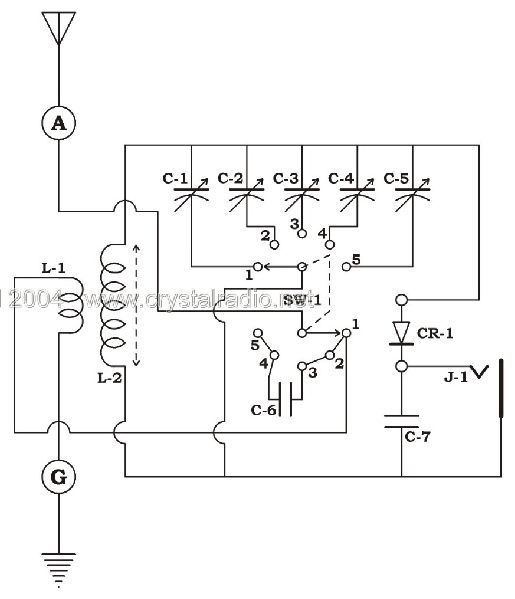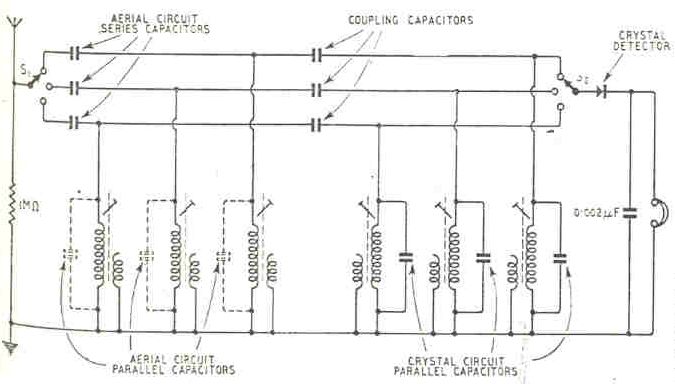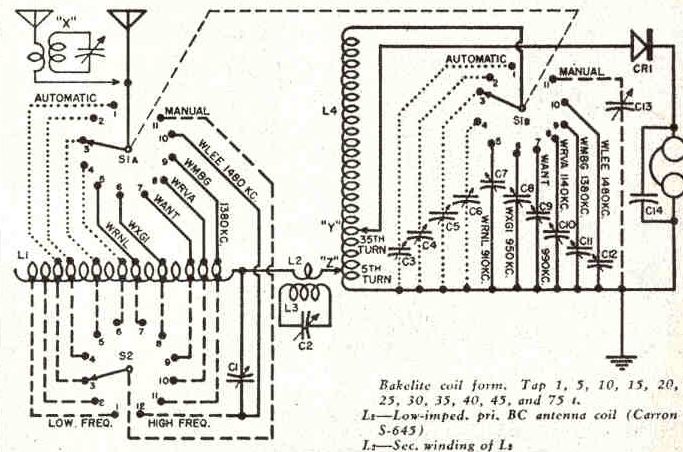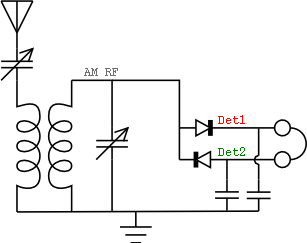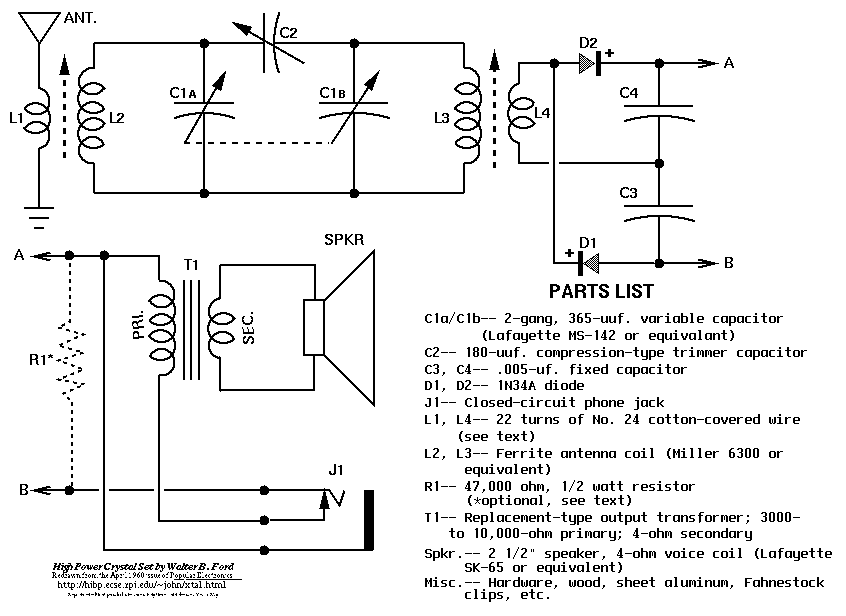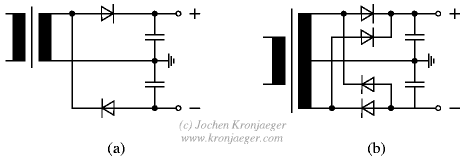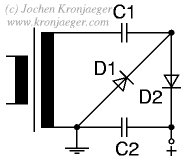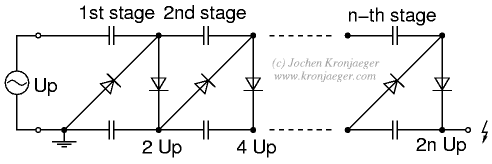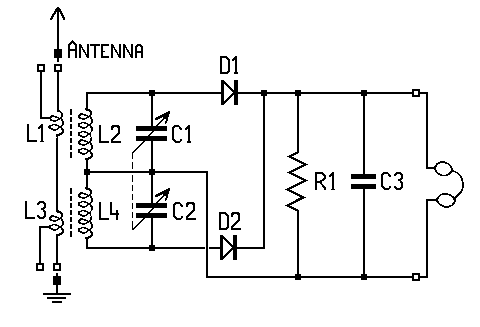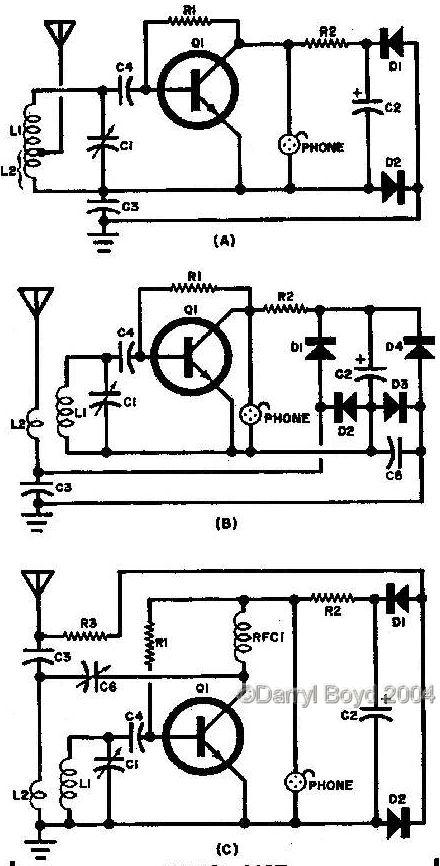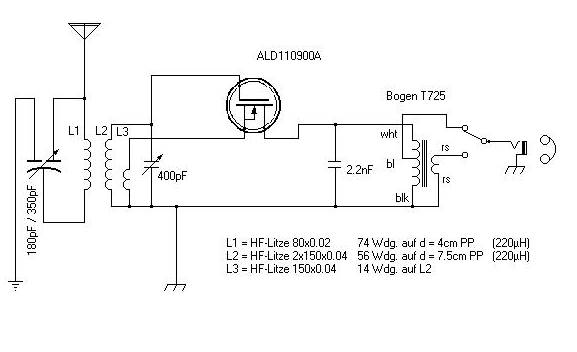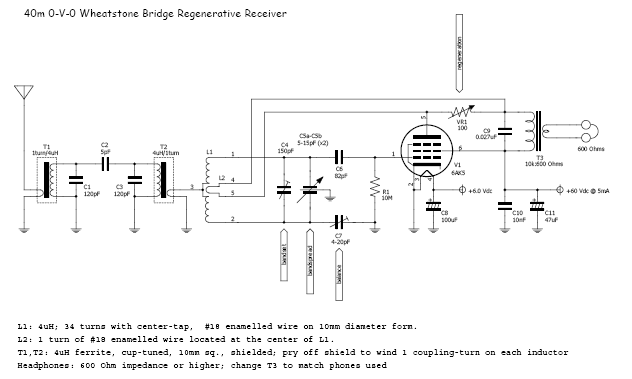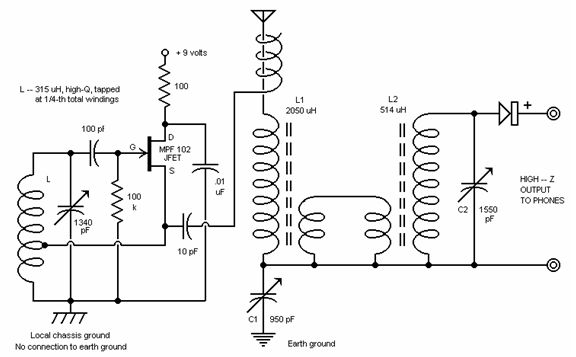Детекторные премники за 120 лет существования
| Повышение квалификации |
Preface (there were much older devices than crystals)
The idea of the passive receiver is more than 100 years old. The first receiver type that is known to detect radio energy is the coherer type. The coherer invented by Edouard Branly and it is a primitive form of radio signal detector, used in the late 19th century, consisting of a capsule of metal filings in the space, sometimes evacuated, between two electrodes. It was a key enabling technology that led to radio, and was the first device used to detect radio signals in practical spark gap transmitter wireless telegraphy. Below is a typical schematic of a coherer type receiver.
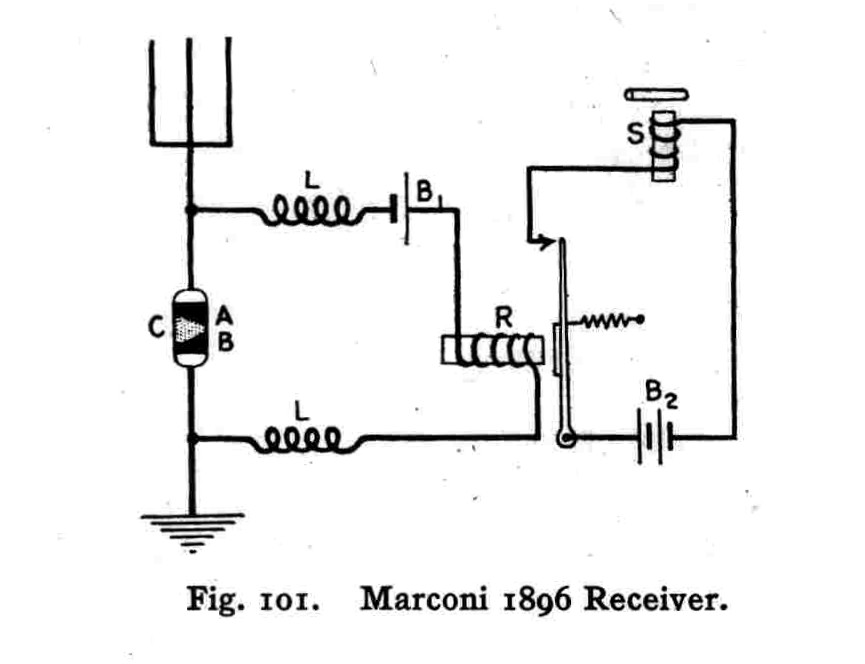
Although the coherer is satisfactory for responding to the "on-off keying" characteristic of an early spark gap transmitter, it cannot follow the complex waveforms of audio broadcasting. This problem was solved by the demodulation capability enabled by the hot wire barretter and the electrolytic detector.
Although the coherer is satisfactory for responding to the "on-off keying" characteristic of an early spark gap transmitter, it cannot follow the complex waveforms of audio broadcasting. This problem was solved by the demodulation capability enabled by the hot wire barretter and the electrolytic detector. Years later he invented the demodulating detector in 1902 that found limited use in early radio receivers. In effect it was a highly sensitive thermo resistor developed to permit the reception of amplitude modulated signals, something that the coherer (the standard detector of the time) could not do.
The hot wire barretter was a demodulating detector invented in 1902 by Reginald Fessenden that found limited use in early radio receivers. In effect it was a highly sensitive thermo resistor developed to permit the reception of amplitude modulated signals, something that the coherer (the standard detector of the time) could not do.
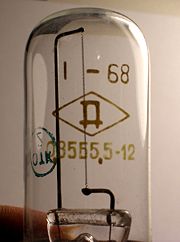
The first device used to demodulate audio signals, it was later superseded by the electrolytic detector, also generally attributed to Fessenden. The electrolytic detector, or the bare-point electrolytic detector as it was also called, was a type of wet demodulator used in early radio receivers. This form of detector was in extensive use, and was very sensitive and reliable.
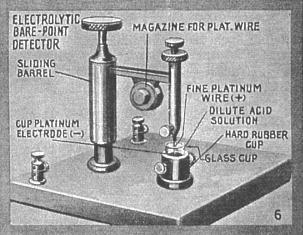
The last and most known part of passive ratio came with the crystal detector. Cat’s whisker crystal detector refers to a thin wire that lightly touches a semi conducting crystal to make an imperfect contact-junction detector in a crystal radio. While originally a figurative description of a mechanical part, the term grew to encompass the entire detector assembly and also in some English speaking communities to describe the receiver itself.
Since then, the technology has been advanced and the materials that composed the crystal detector were packaged into small parts called diodes. One of the most common materials used for the diodes is germanium and so these diodes are called germanium diodes or germanium detectors.
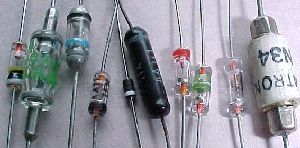
Introduction
Passive receivers have been always fascinated people. The absence of electrical power and the simplicity of the circuits were two of the most important reasons. Other reasons may include the nostalgia for the old, the beauty of the sets and the cabinets etc. In this page I present you the research that I did using internet resources in my try to build a superior crystal receiver. I have been based only on internet resources and it took me one week of continuous search to understand the different circuit topologies and the basics behind the crystal receiver. I made a search package zipped of around 150Mb size. It is available for you upon request. Instead of presenting you the super duper circuit and try to convince you that it is the best (as some home brewers will do), I will try to explain you the reasons why my schematic approach is superior to many others.
I am a person of the new generation but I personally like the way some things were built at the past, but I also consider the disadvantages and the bad points (where they existed) of some of the circuits of this era. I am not the person that will give an ironic look to the many decades home brewers' constructions and I highly respect their opinions but... some things have to be better than the classical way of making them. I always try to support my opinion with arguments and I do not blindly believe a construction to be good if I do not try it myself. That is how I am going to approach the topic in this article.
I am not going to give lot of theory behind this consideration because I want to keep the page simple for the reader. Everything, including the theory, is on the search package for you to read if you want so. Of course nothing is perfect and there is a lot of experimentation that can be done in order to achieve even better results. I will greatly appreciate your comments on any part of the text, at my email address at the beginning of the page.
First of all a few introductory words about crystal receivers.
Crystal receivers are passive devices. The term passive means that they do not use any other electrical power apart from the one that comes from the antenna, i.e. the radio signal. If a receiver fails to follow this rule it cannot be considered as passive.
Crystal receivers cannot achieve any type of amplification (except from some special cases that will be presented in this page). The energy of the out coming signal will always be lower than the energy of the incoming, mainly because of the losses of the different parts of the receiver. One main goal of the experimenter is to minimize these losses as much as possible in order to achieve more signal at the receiver output.
Do not expect great performance by any crystal receiver. The best crystal receiver you can find will be much more inferior to a simple pocket radio of today's technology. I am not telling this to disappoint you but it is the truth. The superheterodyne topology itself is much more inferior than the envelope detector used in crystal receivers. Unless you really need a set that will operate without power and you are able to have a big antenna and good earth, do not go for a crystal receiver, as far as concern performance issues.
After all this introduction let's come to the point of the page.
Sensitivity versus selectivity
Crystal-set DXers are up against two problems: selectivity versus sensitivity. Sensitivity describes the ability of the receiver to receive weak signals. The more sensitive a receiver is, the weaker signals it can receive. Selectivity is the ability of the receiver to distinguish a wanted signal from unwanted others, so you can listen to only this signal and not the unwanted ones. If you have not any means of filtering in your receiver, maybe you could make it more selective by lowering it's sensitivity. But then you would not be able to hear the weaker stations but only the loud ones. Also if two loud stations are close together in frequency, lowering the sensitivity, would not necessarily improve the selectivity. If you live in a city or near a large city that has several AM signals, your main focus will be on separating signals so that the weaker DX can be heard between the blowtorches. On the other hand, if you live in the country, you don't have to worry so much about separating strong locals; you can run things 'wide-open' enabling you to log some of the weaker DX signals. Living away from the city certainly makes life simpler for crystal radio DXing but don't despair if you are a city-dweller.
Topologies of crystal receivers
There are many topologies that can be used in crystal receivers but all of them consist of some main parts. There is always an antenna and an earth, a means of selectivity, a means of detection and a means of audio conversion. The selectivity part is usually composed of coils and capacitors and its purpose is to select the desired signal among unwanted ones. The detection part is usually composed of a detector (crystal ore or diode) and its purpose is to convert the high radio frequency signal to low audio frequency one. The audio conversion part is usually composed of headphones or other devices and its purpose is to convert the audio waveform into air pulses (i.e. sound) for your ears to listen. Below I will present you some basic topologies of crystal receivers that I have come across.
The diagram shows a simple basic crystal radio. It is probably the simplest you can find.
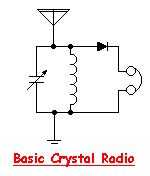 In the city, with a good antenna, such a set will hear plenty of locals but it is unlikely to hear any DX. Take it out to the campground for the weekend however and even a simple set like this is capable of logging DX. Since most of us live in or near the city, we need to look at ways of transforming the basic set into a DX machine!
In the city, with a good antenna, such a set will hear plenty of locals but it is unlikely to hear any DX. Take it out to the campground for the weekend however and even a simple set like this is capable of logging DX. Since most of us live in or near the city, we need to look at ways of transforming the basic set into a DX machine!
In order to separate the strong locals, the tuned circuit (L-C) must have as high a 'Q' as possible. Q, the quality factor of a coil, is the ratio of the inductive reactance (i.e. "AC resistance") of a coil at a particular frequency to the resistive losses of the coil. This resistive component is the sum of the DC resistance and other losses such a dielectric losses in non-conductive material close to the coil and eddy-current losses in nearby conductors or the coil wire itself. High Q not only yields better selectivity, but also raises the impedance of the tuned circuit, which can allow more voltage to be applied to the detector.
Placing the diode and headphone load at the top of this circuit will result in strong signals but poor selectivity. The impedance of the headphones will load down the tuned circuit, lowering its 'Q'. The result is very poor selectivity.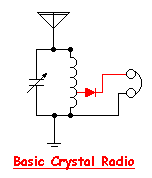 Tapping the diode/headphone load at a lower point in the tuned circuit results in less 'Q-lowering' of the circuit. The result is a higher degree of selectivity. You don't, however, get a free ride! The higher selectivity diode tap point results in less overall voltage being fed to the headphones. Signals are weaker but easier to separate! The challenge of building an efficient tuner is to find the right balance between selectivity and sensitivity!
Tapping the diode/headphone load at a lower point in the tuned circuit results in less 'Q-lowering' of the circuit. The result is a higher degree of selectivity. You don't, however, get a free ride! The higher selectivity diode tap point results in less overall voltage being fed to the headphones. Signals are weaker but easier to separate! The challenge of building an efficient tuner is to find the right balance between selectivity and sensitivity!
There are a few more improvements that will help the 'basic set'. More sensitivity as well as more selectivity can be realized in the antenna circuit. A separate antenna coupling coil that will couple the antenna into the main tuning coil will result in a further overall improvement. 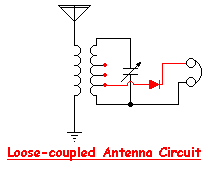 If the position of the antenna coil can be adjusted in relation to the main tuning (detector) coil, a degree of coupling can be reached that offers a good balance point between adequate sensitivity and improved selectivity. Often the antenna coil and the detector coils are mounted on a long rod or dowel that allows easy adjustment of the 'loose-coupling' circuits. Also note that improved detector tuning can be achieved by optimizing the diode 'tap' location on the main tuning coil.
If the position of the antenna coil can be adjusted in relation to the main tuning (detector) coil, a degree of coupling can be reached that offers a good balance point between adequate sensitivity and improved selectivity. Often the antenna coil and the detector coils are mounted on a long rod or dowel that allows easy adjustment of the 'loose-coupling' circuits. Also note that improved detector tuning can be achieved by optimizing the diode 'tap' location on the main tuning coil.
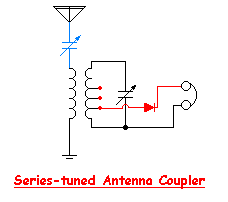 Further improvements in both sensitivity and selectivity can be achieved by actually tuning the antenna system to resonance. Your type of antenna system as well as the part of the AM band that you are tuning will determine which system works best. The series-tuned antenna coupler is best suited for tuning large antennas, especially those with large horizontal runs ("top hats"). The parallel-tuned antenna coupler is better suited for tuning shorter antennas, such as vertical wires, masts or whips - those without top hats.
Further improvements in both sensitivity and selectivity can be achieved by actually tuning the antenna system to resonance. Your type of antenna system as well as the part of the AM band that you are tuning will determine which system works best. The series-tuned antenna coupler is best suited for tuning large antennas, especially those with large horizontal runs ("top hats"). The parallel-tuned antenna coupler is better suited for tuning shorter antennas, such as vertical wires, masts or whips - those without top hats. 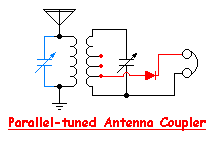 A series of test clips or a simple switching system can be used experimentally to determine what works best for you. Making this effort is important as it goes a long way towards avoiding initial disappointment with the crystal set's performance. Such a system as this is called a 'double-tuned' set. With care and attention to construction, such systems are capable of hearing DX signals.
A series of test clips or a simple switching system can be used experimentally to determine what works best for you. Making this effort is important as it goes a long way towards avoiding initial disappointment with the crystal set's performance. Such a system as this is called a 'double-tuned' set. With care and attention to construction, such systems are capable of hearing DX signals.
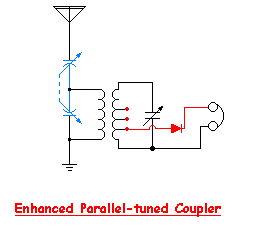 Adding a tuning capacitor in series with the antenna permits a long antenna to be tuned very effectively by a parallel-tuned antenna coupler. In fact, this is the method-of-choice for many crystal set listeners. To avoid the complication of an extra tuning knob, a single-knob, two-gang variable capacitor can be used as shown here. The added variable capacitor can be placed instead in the ground leg. This 'enhanced parallel-tuned' coupler can be very effective in peaking up desired signals while knocking down nearby interference. The use of a tapped coil in this circuit can be very beneficial in achieving optimal Q for the portion of band being tuned. One might even decide on using separate 'high-band' and 'low-band' coils for this circuit.
Adding a tuning capacitor in series with the antenna permits a long antenna to be tuned very effectively by a parallel-tuned antenna coupler. In fact, this is the method-of-choice for many crystal set listeners. To avoid the complication of an extra tuning knob, a single-knob, two-gang variable capacitor can be used as shown here. The added variable capacitor can be placed instead in the ground leg. This 'enhanced parallel-tuned' coupler can be very effective in peaking up desired signals while knocking down nearby interference. The use of a tapped coil in this circuit can be very beneficial in achieving optimal Q for the portion of band being tuned. One might even decide on using separate 'high-band' and 'low-band' coils for this circuit.
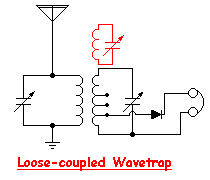 Although you may now be able to hear some DX, chances are you are still bothered by at least one (if not several) local 'pest' signals. Further gains in selectivity can be had by the addition of another tuned circuit, called a 'wavetrap'. By coupling this circuit to the detector coil, this circuit can be tuned to the same frequency of the pest signal, absorbing much of its signal-killing strength at the detector, while not adversely affecting the strength of wanted signals. More than one wavetrap may be employed to tackle more than one pest signal. With a high Q wavetrap, very loose coupling is usually best.
Although you may now be able to hear some DX, chances are you are still bothered by at least one (if not several) local 'pest' signals. Further gains in selectivity can be had by the addition of another tuned circuit, called a 'wavetrap'. By coupling this circuit to the detector coil, this circuit can be tuned to the same frequency of the pest signal, absorbing much of its signal-killing strength at the detector, while not adversely affecting the strength of wanted signals. More than one wavetrap may be employed to tackle more than one pest signal. With a high Q wavetrap, very loose coupling is usually best.
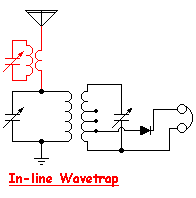
Another method that some find successful is the use of an 'in-line' wavetrap in the antenna circuit. The smaller secondary winding can be wound either on top of the primary or on one end. One or two in-line wavetraps can often be used to effectively knockdown the strong pest signals.
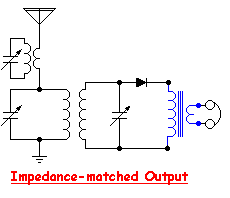 Another important improvement can be made in the headphone circuit. If you are using the old standard style of headphones (Brush, Baldwin etc) they must be high impedance phones. The modern low-impedance 'walkman' style phones will load-down the detector circuit too much, seriously degrading selectivity and signal strength. Even high impedance phones will cause unwanted loading of the detector circuit. Using a low-loss audio transformer with a very high impedance primary between the phones and the detector will reduce the problem and often great gains in selectivity can be achieved.
Another important improvement can be made in the headphone circuit. If you are using the old standard style of headphones (Brush, Baldwin etc) they must be high impedance phones. The modern low-impedance 'walkman' style phones will load-down the detector circuit too much, seriously degrading selectivity and signal strength. Even high impedance phones will cause unwanted loading of the detector circuit. Using a low-loss audio transformer with a very high impedance primary between the phones and the detector will reduce the problem and often great gains in selectivity can be achieved.
This is the schematic diagram of a good performance receiver based on the above considerations. 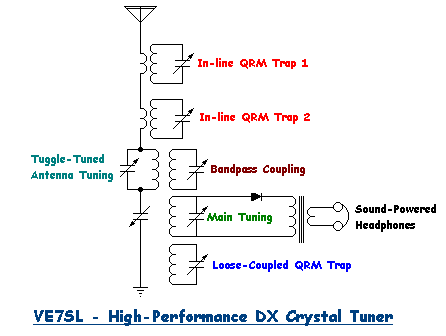
This is a 'triple-tuned' arrangement. There are vernier reduction drives on all tuning capacitors as tuning is very sharp on all circuits. Because of the great abundance of 'blowtorch' signals within 15 miles of my location (seven 50 KW locals) heavy trapping of pests is required. Both sensitivity and selectivity are quite good.
Below many other additional approaches are presented. There is no better description than the original articles so please click on each picture to view or download the relevant article.
The second picture below uses a band pass filter to select the desired station. The fourth picture uses a wave trap and offers both broad and selective tuning to be made.
More classic schematics.
The schematic below uses double tuned circuits linked together by a link line, so it could be build in two boxes maby.
The three schematics below incorporate the use of a variometer (variable coil inductively varied, not selective).
Many other circuits in the boy's book of crystal sets.
The next seven circuits use band pass filters in order to improve selectivity. A band-pass filter is a device that passes frequencies within a certain range and rejects (attenuates) frequencies outside that range. These filters can be created by combining a low-pass filter with a high-pass filter and that is the case here. Band pass filters are quite sharp and they are used extensively not only in crystal radio but in all forms of receivers.
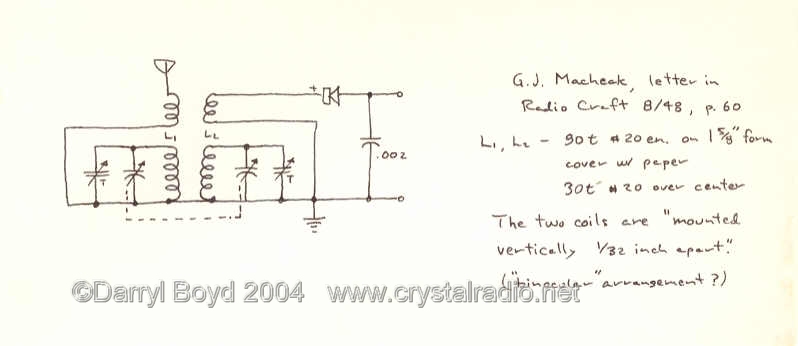
The next three circuits show you how you can construct your crystal receiver in order to have memories of pre-selected stations. A crystal receiver can have memories? Of course it can. Not electronic memories but rather a set of multiple tuned circuits, each one tuned to a predetermined station in the band. Using a multi-switch you can select the desired stored station by selecting the relevant tuned circuit. That is a clever technique but it requires you to multiply the tuned circuits of the receiver by the number of the memories you want to have.
Up to this point I have shown you most of the more conventional crystal receiver topologies. Now I am going to show you a different approach to the topic. The next circuits could be described as more modern circuits.
In a conventional crystal receiver the diode delivers power to the headphone during the positive part of the RF cycle. The negative part of the RF cycle goes nowhere. We went to all the trouble to put up a 100 foot antenna and then waste half the energy we manage to capture. In the first picture below the top diode delivers power to the headphone during the positive part of the RF cycle and the bottom diode delivers power during the negative part of the RF cycle. In your typical crystal radio the voltage across the headphone comes from Det1 and ground (0 volts), so it has a magnitude equal to that of Det1. By putting the voltage from Det2 at the other side of the headphone, we get a difference of Det1-Det2 across the headphone (i.e. a greater voltage). Of course, this isn't exactly how it works. Really, the forward voltage drop of the diodes has a big effect on the output voltage, and all kinds of impedance interactions probably show up when you hook up another detector. So I do not know how efficient this circuit can be. But, this should get the idea across. A person could go through a lot of math to figure out exactly what happens. I think it's easier and more satisfying to just build the thing and see how good it works.
The next two circuits use another technique called voltage doubling to double the voltage that comes into the headphones. These are generally more effective detectors.
In order to understand better the how voltage doubling works consider the following. There are two types of voltage doublers. The Greinacher and the Villard.
Greinacher voltage doubler
|
|
Greinacher voltage doubler circuit. (a) simple version for grounded input voltage, (b) double version for symmetric input voltage. Diodes must be dimensioned for 2x input peak voltage Up, caps only for 1x Up. |
The Greinacher doubler circuit (a) transforms a grounded AC voltage (peak voltage Up) into symmetrical DC voltages of 1x Up each, thus producing 2x Up between outputs. If the input voltage is already symmetrical (e.g. as in an Obit), the Greinacher circuit may be doubled according to (b). This does not change the output voltages but increases the possible output current by a factor of two.
Villard voltage doubler
|
|
Villard voltage doubler circuit for positive polarity towards ground. For negative polarity reverse all diodes. Diodes and caps must be dimensioned for 2x Up. For sinusoidal input voltage 1x Up is sufficient for C1. |
In contrast to the Greinacher circuit, the Villard doubler circuit produces 2x Up towards ground at a single output. Besides this, the advantage of the Villard circuit is that it may be cascaded to form a voltage multiplier with (in principle) arbitrary output voltage. The way this works is that after C1 and C2 are fully charged to 1x and 2x Up respectively, there is a pulsating DC voltage oscillating between 0 and 2x Up across D2, which is converted to AC by the subsequent cap and thus acts as input AC of the next stage, and so forth.
Villard cascade
|
|
Cascaded Villard doubler circuits. All diodes and caps must be dimensioned for 2x Up. For sinusoidal input voltage, C1 of the first stage may be reduced to 1x Up. |
The next three circuits are examples of another type of detection, the full wave detection. These are not similar to the double diode circuits described above and they do not use the previously mentioned voltage doublers, yet they are very efficient and they provide some advantages over the voltage doubler circuits that will be discussed later on.
The best way to understand how this type of detector works is to compare it with the full wave rectification of the power supply units.
In half wave rectification, either the positive or negative half of the AC wave is passed, while the other half is blocked. Because only one half of the input waveform reaches the output, it is very inefficient if used for power transfer. Half-wave rectification can be achieved with a single diode in a one phase supply, or with three diodes in a three-phase supply.

A full-wave rectifier converts the whole of the input waveform to one of constant polarity (positive or negative) at its output. Full-wave rectification converts both polarities of the input waveform to DC (direct current), and is more efficient. However, in a circuit with a non-center tapped transformer, four diodes are required instead of the one needed for half-wave rectification. This has some disadvantages that we will see later on. Four rectifiers arranged this way are called a diode bridge or bridge rectifier:

For single-phase AC, if the transformer is center-tapped, then two diodes back-to-back (i.e. anodes-to-anode or cathode-to-cathode) form a full-wave rectifier (in this case, the voltage is half of that for the non-tapped bridge circuit above, and the diagram voltages are not to scale). However this is a very good case for the crystal receiver for reasons that will be discussed later on.

I said earlier that crystal receivers cannot achieve any type of amplification, except from some special cases. The next notes and schematics have to be considered with great interest. They achieve amplification without using external power other than the one comes from the antenna. They are still crystal receivers and they still use detectors. The diodes here, are not used for signal detection but they deliver power to the transistor amplifier/detector. One could argument that this may degrade the wanted signal. But what is actually happening is that the power needed for the transistor is not taken from the wanted signal itself but from the unwanted ones that the antenna receives. In this case, the greater the RF interference in an area, the better.
Two other examples of such receivers are shown below. They use FETs as RF amplifiers and detectors. I do not know if they use unwanted or wanted signals for the power required for the FETs to work and I am not sure if they can be considered as crystal receivers as they do not use any diodes or germanium transistors. But nevertheless, the topic of the project is not only about crystal receivers but generally about passive receivers. The rectification is done by the FET itself. Well no one says that a crystal receiver must use only diodes or germanium transistors for detection, although the word "crystal" denotes this. In the context that they do not use external power they can be considered as crystal receivers but in the context that they do not use diodes/germanium transistors for rectification they cannot. The certain thing is that they do not use external power and this makes them passive. They also offer some advantages over diode crystal sets.
Here you can find more details of how to build such circuits
Below there are some more schematics and descriptions (above them) about such circuits.
Simple Crystal set for local transmitter
You can use also a crystal phone (x = 3 K OHM). For weak signals you can shorten the amplifier switch. Transistors: AC151, AC104, OC76, SB187. Rectifiers: AA112, AA114, AA132, OA85. L= 100 or 120 wdg with diameter 2 cm, C= 500pf for MW.
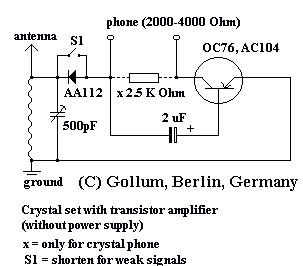
Crystal receiver with AF-amplifier for your local broadcast transmitter. Model 1
The rectified RF is smoothed with R1 and C3 and is the "source" for the voltage energy of the AF - transistor. Disadvantage of the receiver: The voltage stands only at strong transmitter at the disposal. On the other hand is loudspeaker - reception realizable. L= 100 or 120 wdg with diameter 2 cm, C1= 500pf, C2= 1nf, C3= 3uf, C4= 0.1 uf, C5= 500 500pf, R1= 1M, R2= 1M, transformer 6/1 or 4/1, transistor: AC151, AC104, OC76, SB187 rectifier: AA112, AA114, AA132, OA85.
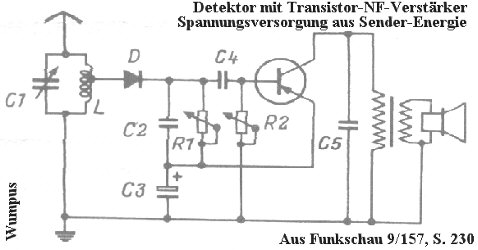
Crystal receiver with AF-amplifier for your local broadcast transmitter. Model 2
The second concept is more profitable. The transistor - energy is produced from a separate resonance-circuit. This circuit (L1/C3) is tuned firmly on the local transmitter, Circuit C4/L2 is tuned for radio reception. Good loudspeaker - reception, also at weaker transmitters, is the result. As transistors are indeed germanium - types necessary. You need a operation voltage of about 800 mV at C8 for well working.
Transistors: AF preamplifier T1 = OC71 ( NKT214, 2N280, 2SB244) , AF final amplifier T2 = OC 72 (2SB56, NKT212, 2N281). R1 = 75 KOhm, R2 = 100 KOhms, C8 = 100 uF, C5 = 500 pF, C6 und C7 = 10 uF, transformer Tr1 = 1/1 ratio Z approx. 4000/4000 Ohms, transformer Tr2 = 2/1 ratio Z =2000/1000 Ohms, transformer Tr3 = Z 200/4-5 Ohms. L1 and L 2= 100 wdg with diameter 2 cm (tap for D1 80 wdg from ground) , C3/C4= 500pf, rectifiers: AA112, AA114, AA132, OA85. I think, you have problems to buy the transformers. Perhaps you find an old low price transistor portable with some transformers.
Adjust the trimmers R1 and R2 for best audio quality (bias voltage between basis and emitter of approx. 350-450 mV).
Version 2: For best performance use separate antennas for power supply detector and receiver detector. L1 except tap. A1 for power supply detector. C9 = ceramic 1nF. With the (high ohm) voltage meter you can adjust to highest voltage. Use a instrument with a full range of 3 to 10 V in relation to the max. voltage on your location..

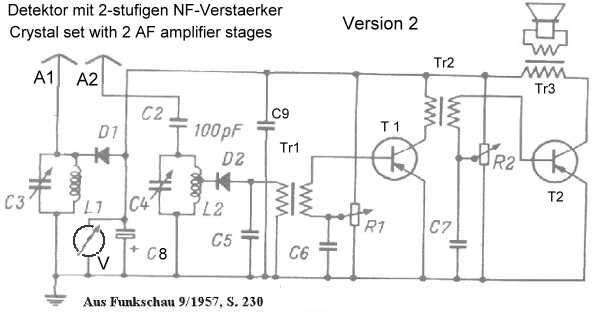
Crystal receiver with AF-amplifier also for long-distance broadcast reception.
This is a high performance project because the supply voltage needed for the transistor amplifier is generated by the local broadcast station to which crystal receiver number 1 (left side of the schematic) is fix-tuned. Tune with the aid of a meter and adjust for maximum detection. Good AF amplification also of low-level stations with the crystal receiver number two (right side of schematic). Use a Germanium low signal AF type transistor (AC151 or 2SB187, etc.). A supply voltage as low as 450 mV produces audible signal amplification. Of course you have to use TWO antennas.
I use for the crystal receiver number 2 (right) a loop (frame) antenna, for crystal receiver number 1 (left) I use a 20 meters (66 feet) wire outside antenna. This generates a supply voltage of approx. 900 mV under load of receiver number 2.
Adjust the variable 250 k ohms resistor to approx 50 % of the voltage generated by receiver number 1 voltage (measured at + pole). Best value for 10 k ohms trim pot is 3 to 6 k ohms.
Do not use electrolytic for the 0.1 uF capacitors. Do not forget to install the 1 nF capacitor. The 150 k ohms resistor of receiver number 1 is not really necessary. Attention for the polarity of the diode in receiver number 1.
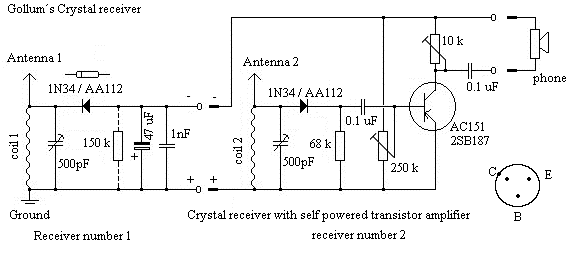
Crystal receiver with RF-amplifier for long-distance broadcast reception.
This concept is effective since the supply voltage for the transistor amplifier is provided by a separate tuned circuit which is fix-tuned to the local radio station and thus is constantly available (tune to maximum output with a suitable meter). Unlike the previous circuit this time the radio frequency is amplified, not the audio frequency. This concept is more suitable for long distance reception.
Good sensitivity by rf amplification. The transistor required is a germanium rf type (an AF101 or 2SA175 or other rf type). Already a voltage of about 450 mV produces audible amplification. You will HAVE TO USE two separate antennas. Coils used have ferrite (powered iron) cores, variable capacitors are solid dielectric types with 500 pF. The rf chokes (RFC 1 and 2) may be made by winding about 200 turns of this enameled copper wire on a ferrite slig with a diameter of 10 and a length of 50 millimeters.
For detector receiver number two I used at night-time a loop antenna and for detector radio number one (left side of schematic) I use an out-side wire antenna of 20 meters length. This set-up produces a voltage of about 900 mV under load of the second detector set.
Adjust the 25 k-ohms trimmer for the loudest signal.
The 150 k-ohms resistor is not really necessary. Watch the polarity of the diode in the receiver number 1.
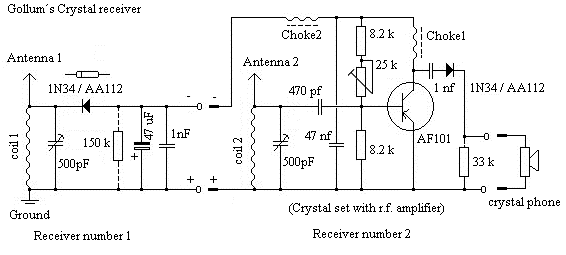
For 2000 ohms magnetic headphones
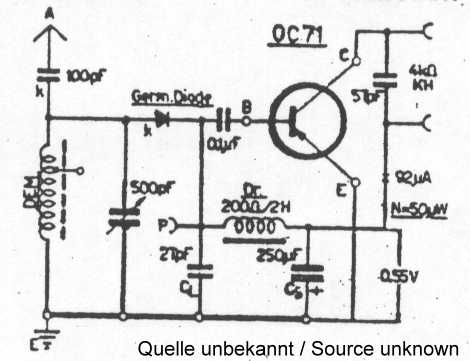
For 4-5 ohms earphone
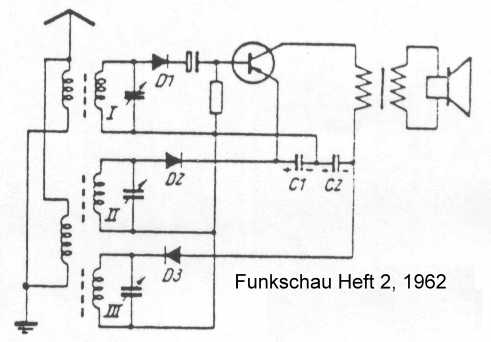
For 2000 ohms magnetic headphones
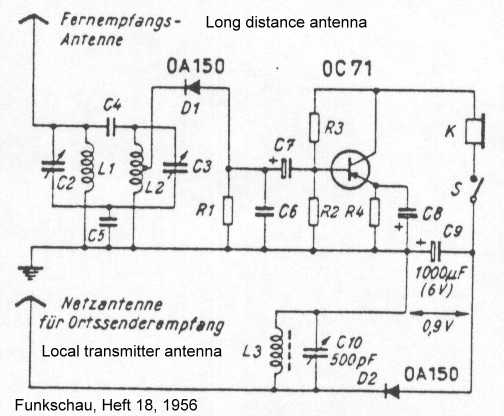
SW-band crystal set with transistor AF amplifier powered by the transmitter energy.
An alternative use of a battery is possible. A second receiver for MW band delivers the voltage for the transistor amplifier. With S2 you can connect the headphones direct to the crystal set or to the output of the AF transistor amplifier. The 20 uA measuring instrument is for best tuning of the SW broadcast station. 2000 ohms headphones.
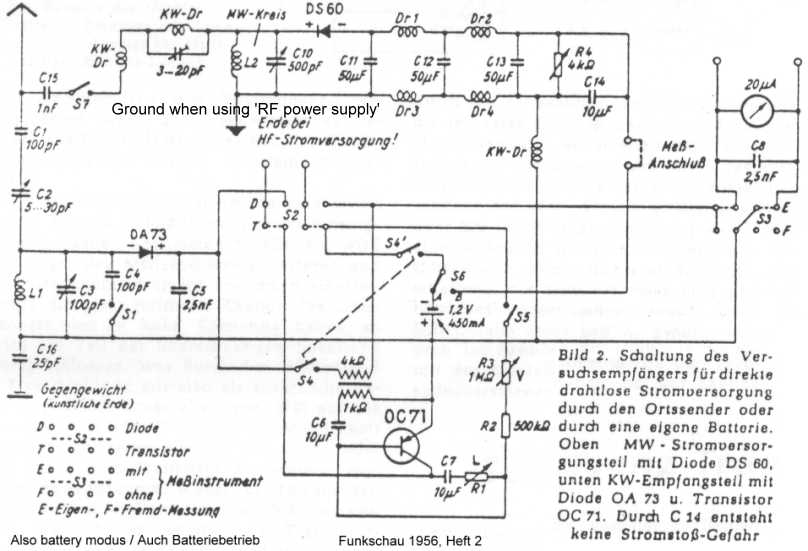
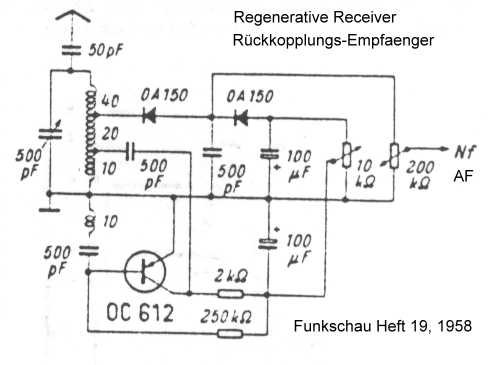
Another type of such radio that describes a vacuum tube Wheatstone Bridge 0-V-0 Regenerative Receiver with Passive hybrid reverse antenna isolation
All the crystal receivers described above are able to detect only AM (amplitude modulated) signals. The next circuits are definitely not crystal receivers. They use a combination of a passive and an active circuit. The reason why I present them to you is that they are capable of demodulating SSB (single side band) signals. If one could make the BFO taking power from the antenna, like the circuits I presented above, then these would be SSB crystal sets. This is a very good point of experimentation for someone that would like to try.
http://www.qrp.gr/xtalpage/index.htm
